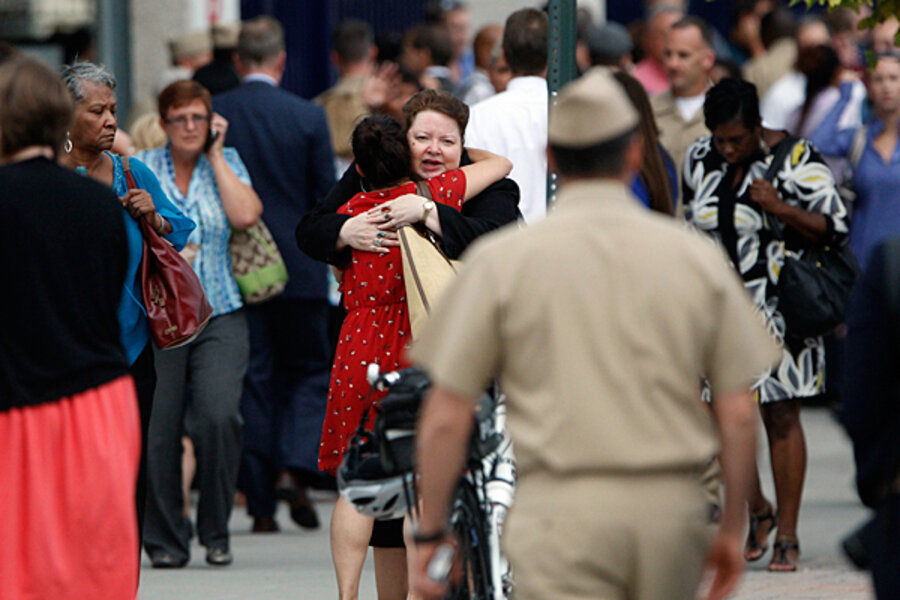Navy Yard shooting: What to do about attacks on US military at home?
| Washington
Countless questions remain unanswered about the terrible slaughter of 12 people Monday morning at the Washington Navy Yard in the nation's capital by a 34-year-old former Navy electrician, whom authorities have identified as Aaron Alexis. But what is clear is that US military installations – and the people who work there – are increasingly being targeted inside the nation's own borders.
Monday's attack, in which all those killed worked for the military, is the third in four years. The Pentagon, which is less than 5 miles from the navy yard, immediately stepped up security “not out of a specific threat, but as a proactive, precautionary measure,” said Pentagon press secretary George Little.
Defense officials, moreover, are moving to evaluate protective measures that could be taken in the longer term at other military installations in the region.
“It’s a shooting that targeted our military and civilian personnel,” President Obama said Monday at the White House. “They know the dangers of serving abroad, but today they faced the unimaginable violence that they wouldn’t have expected here at home.”
Defense Secretary Chuck Hagel offered his sympathies for “the victims of this outrageous act of violence, their families, and all those affected by today’s events.”
What prompted the suspect to open fire at the navy yard before 8:30 Monday morning is unclear, and the alleged gunman died at the scene. The attack does not appear, however, to be an act of terrorism, say Department of Homeland Security officials.
Still, Eleanor Holmes Norton, the District of Columbia's delegate to Congress, said, “We’ve not had a day like this” in Washington since the 9/11 terrorist attacks.
Mr. Alexis served in the US Navy from May 2007 to January 2011, most of that time in Fort Worth, Texas, according to a bio sheet the Navy released late Monday. Attached to the Fleet Logistics Support Squadron (VR) 46, he worked on the electric systems of Navy airplanes, and by December 2009 had achieved the rank of aviation electrician's mate 3rd Class. More recently, he was reportedly employed by a private defense contractor.
At MedStar Washington Hospital Center, where some of those injured in the shooting were being treated, US military physicians who rotate through the trauma center to keep their skills sharp while not at war are attending to their fellow US troops, a hospital official told reporters.
The tragedy comes less than a month after a US Army psychiatrist – who had been promoted to major before his conviction stripped him of his rank – was sentenced to death for the 2009 massacre of 13 people at the military base in Fort Hood, Texas. Nidal Hasan, a Muslim American, has said his shooting was meant to prevent US troops, who were about to deploy to Afghanistan, from killing Taliban leaders and fighters upon their arrival.
In 2010, the FBI investigated a series of shootings at Marine Corps facilities and the Pentagon in the Washington, D.C., metropolitan area. Shots were fired overnight into windows of the Pentagon, recruiting centers, and the National Museum of the Marine Corps. No one was injured in these shootings.
In June 2011, the FBI arrested a 22-year-old Marine reservist, Yonathan Melaku, after he was discovered in Arlington National Cemetery with spray paint and a plan to deface the tombstones of US troops who had served in Iraq and Afghanistan. Bombmaking and explosives documents were later found on his computer. Mr. Melaku, a native of Ethiopia, enlisted in the US military in 2007 and became a naturalized US citizen in 2009.
His family said his behavior changed after he joined the Marines. Melaku himself told investigators he was radicalized in 2003, after the start of the Iraq war. In January, a federal court sentenced Melaku to 25 years in prison.
Monday's attack on US military personnel took place at the Naval Sea System Command’s headquarters, a workplace for more than 3,000 people responsible for buying and maintaining the Navy's ships and submarines.
The headquarters, known as NAVSEA, has a $30 billion-a-year budget, about one-quarter of the Navy’s annual spending, according to a US Navy spokesperson. NAVSEA employs some 60,000 military service members, civilians, and contractors around the country.





